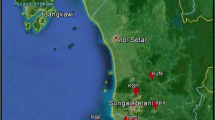Abstract
Random amplified polymorphic DNA (RAPD) amplified by the polymerase chain reaction (PCR) was used to estimate the relatedness of three biotypes of brown planthopper, Nilaparvata lugens (Stål), from the Philippines. Each individual brown planthopper had a unique set of RAPD bands, but no bands were diagnostic for any one biotype. Brown planthopper types 1, 2 and 3 were genetically homogeneous. This supports results of other studies which conclude that brown planthopper biotypes are not sub-specific categories, but merely represent individual variation for virulence to rice cultivars.
Résumé
Le random amplified polymorphic DNA amplifié au PCR (RAPD-PCR) a été utilisé pour determiner les liens de parenté de trois biotypes de la sauterelle brune, Nilaparvata lugens (Stål), provenant des Philippines. Chaque sauterelle brune a un lot unique de band RAPD mais aucune bande n’a été identifiée pour un quelconque biotype. Les biotypes 1, 2 et 3 de la sauterelle brune était génétiquement homogenes. Ce resultat est en accord avec ceux d’autres études qui ont conclu que les biotypes de la sauterelle brune ne sont pas des catégories subspécifiques mais ils représentent plutôt des variations individuelles de virulence à l’encontre des cultivars de riz.
Similar content being viewed by others
References
Black W. C. IV (1993) PCR with arbitrary primers: Approach with care. Insect Molec. Biol. 2, 1–6.
Black W. C. IV, DuTeau N. M, Puterka G. J., Nechols J. R. and Pettorini J. M. (1992) Use of random amplified polymorphic DNA-polymerase chain reaction (RAPD-PCR) to detect DNA polymorphisms in aphids (Homoptera: Aphididae). Bull. Entomol. Res. 82, 151–159.
Claridge M. F. and Den Hollander J. (1983) The biotype concept and its application to insect pests of agriculture. Crop Prot. 2, 85–95.
Claridge M. F., Den Hollander J. and Haslam D. (1984) The significance of morphometric and fecundity differences between the “biotypes” of the brown planthopper, Nilaparvata lugens. Entomol. Exp. Appl. 36, 107–114.
Den Hollander J. (1989) Electrophoretic studies on planthoppers and leafhoppers of agricultural importance. In Electrophoretic Studies on Agricultural Pests. System. Assoc. Special Vol. 39 (Edited by Loxdale H. D. and Den Hollander J.), pp. 297–315. Clarendon Press, Oxford.
Kambhampati S., Black W. C. IV and Rai K. S. (1992) Random amplified polymorphic DNA of mosquito species and populations (Diptera: Culicidae): Techniques, statistical analysis, and applications. J. Med. Entomol. 29, 939–945.
Khan Z. R. and Saxena R. C. (1990) Purification of biotype 1 population of brown planthopper Nilaparvata lugens (Homoptera: Delphacidae). Insect Sci. Applic. 11, 55–62.
Nei M. (1978) Estimation of average heterozygosity and genetic distance from a small number of individuals. Ann. Hum. Genet. 41, 225–233.
Pathak P. K. and Heinrichs E. A. (1982) Selection of biotype populations 2 and 3 of Nilaparvata lugens by exposure to resistant rice varieties. Environ. Entomol. 11, 85–90.
Puterka G. J., Black W. C. IV, Steiner W. M. and Burton R. L. (1993) Genetic variation and phylogenetic relationships among worldwide collections of the Russian wheat aphid, Diuraphis noxia (Mordvilko), inferred from allozyme and RAPD-PCR markers. Heredity 70, 604–618.
Roehrdanz R. L., Reed D. K. and Burton R. L. (1993) Use of polymerase chain reaction and arbitrary primers to distinguish laboratory-raised colonies of parasitic Hymenoptera. Biol. Control 3, 199–206.
Saxena R. C. and Barrion A. A. (1985) Biotypes of the brown planthopper Nilaparvata lugens (Stål) and strategies in deployment of host plant resistance. Insect Sci. Applic. 6, 271–289.
Saxena R. C., Demayo C. G. and Barrion A. A. (1991) Allozyme variation among biotypes of the brown planthopper Nilaparvata lugens in the Philippines. Biochem. Genet. 29, 115–123.
Shufran K. A., Margolies D. C. and Black W. C. IV (1992) Variation between biotype E clones of Schizaphis graminum (Homoptera: Aphididae). Bull. EntomoL Res. 82, 407–416.
Swofford D.L. and Selander R.B. (1981) BIOSYS-1: A FORTRAN program for the comprehensive analysis of electrophoretic data in population genetics and systematics. J. Hered. 72, 281–283.
Williams J. G. K., Kubelik A. R., Livak K. J., Rafalski J. A. and Tingey S. V. (1990) DNA polymorphisms amplified by arbitrary primers are useful genetic markers. Nucleic Acid Res. 18, 6531–6535.
Author information
Authors and Affiliations
Rights and permissions
About this article
Cite this article
Shufran, K.A., Whalon, M.E. Genetic Analysis of Brown Planthopper Biotypes Using Random Amplified Polymorphic DNA-Polymerase Chain Reaction (RAPD-PCR). Int J Trop Insect Sci 16, 27–33 (1995). https://doi.org/10.1017/S1742758400018282
Accepted:
Published:
Issue Date:
DOI: https://doi.org/10.1017/S1742758400018282




